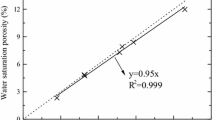Abstract
Carbon Capture and Storage (CCS) is one of the solutions studied to reduce greenhouse gas accumulation in the atmosphere. Depleted oil and gas reservoirs have been studied for potential storage sites but also saline aquifers that have the advantages of much larger pore volume. In this latter case, injection of large volume of anhydrous carbon dioxide will lead to a strong water desaturation of the near wellbore region because of evaporation mechanisms. Even the capillary trapped water can be removed by thermodynamical transfer of water vapor in the CO2 phase. The extension in time and space of the dry zone will be controlled by the drying rate induced by the gas flow. Consequences of drying may induce alteration of the injectivity by salt precipitation and/or alteration of the rock fabric itself, especially for shaly sandstones in the case of clay drying. The context of CCS has raised new interests in the understanding of drying kinetic where the water vapor is evacuated by gas convection. In this study, we investigated experimentally the drying rate evolution with time on a shaly sandstone sample in two conditions of drying: convective and diffusive. In convective conditions, air is injected at different flow rates through the porous media in conditions of drying representative of a CO2 injection site at one million ton per year. In diffusive conditions, no flow is imposed and the water vapor escape by diffusion. Drying rates dynamics in both conditions were measured by Nuclear Magnetic Resonance (NMR) and compared. We varied the temperature and the salinity in diffusive-driven drying and the gas flow rate in convective-driven drying. The water distribution in the pore network and the water saturation profiles were monitored continuously using T2 relaxation and 1D imaging NMR techniques. For the range of temperature and air flow rate used, we show that drying rates in the two drying conditions are similar but not identical. They both present different periods characteristic of the main mechanisms for water mass transfer. Drying rate has a power law dependence on the temperature, as predicted by thermodynamic, and drying rate was found proportional to the flow rate in convective drying. Presence of salt has a complex effect: an increase of the drying rate at early stage of drying followed by a strong decrease for the remaining time of drying.
Similar content being viewed by others
References
Chauvet F., Duru P., Geoffroy S., Prat M.: Three periods of drying of a single square capillary tube. Phys. Rev. Lett. 103, 124502 (2000)
Coussot P.: Scaling approach of the convective drying of a porous medium. Eur. Phys. J. B. 15, 557–566 (2000)
Godefroy, S., Korb, J.P., Fleury, M., Bryant, R.G. : Surface nuclear magnetic relaxation and dynamics of water and oil in macroporous media. Phys. Rev. E. 64(2), 021605 (2001)
Han M., Youssef S., Rosenberg E., Fleury M., Levitz P.: Deviation from Archie law in partially saturated porous media: wetting film versus disconnectedness of the conducting phase. Phys. Rev. E 79(3), 031127 (2009)
Hurter, S., Labregere, D., Berge, J.: Simulations for CO2 injection projects with compositional simulator, SPE 108540 (2007)
IPCC: Carbon Dioxide Capture and Storage In: Metz, B., Davidson, O., de Coninck, H.C., Loos, M., Meyer, L.A. (eds.) Prepared by working group III of the intergovernmental panel on climate change, 442 pp. Cambridge University Press, Cambridge, United Kingdom and New York, NY, USA (2005)
Kamath J., Laroche C.: Laboratory-based evaluation of gas well deliverability loss caused by water blocking. SPE J. 8(1), 71–80 (2003)
Khilar K.C., Fogler H.S.: The existence of critical salt concentration for particles release. J. Colloid Interf. Sci. 101, 214–224 (1984)
Mahadevan J., Sharma M.M., Yortsos Y.C.: Flow-Through drying of porous media. AIChE J. 52, 2367–2380 (2006)
Mahadevan J., Sharma M.M., Yortsos Y.C.: Water removal from porous media by gas injection : experiments and simulation. Trans. Porous Med. 66, 287–309 (2007)
Müller N., Qi R. Mackie E, Pruess K. Blunt M.J.: CO2 injection impairment due to halite precipitation. In: Proceeding of the GHGT-9 conference, Washington (2008)
Ndeau J.P., Puiggali J.R.: Drying—From physical properties to industrial processes. Tec&Doc Lavoisier, Paris (1995) (in French)
Parekh, B., Sharma, M.M.: Cleanup of water blocks in depleted low-permeability reservoirs, SPE paper, 89837 (2007)
Pruess K., Müller N.: Formation dry-out from CO2 injection into saline aquifers: 1. Effects of solid precipitation and their mitigation. Water Resour. Res. 45, W03402 (2009)
Puiggali J.R., Quintard M.: Properties and Simplifying Assumptions For Classical Drying Models, Advances in Drying, Chap. 4. Hemisphere publishing, Washington (1992)
Sghaier N., Prat M., Ben Nasrallah S.: On ions transport during drying in a porous medium. Transp. Porous Med 67, 243–274 (2007)
Sghaier N., Prat M.: Effect of efflorescence formation on drying kinetics of porous media. Trans. Porous Med. 80, 441–454 (2000)
Shahidzadeh-Bonn N., Desarnaud J., Bertrand F., Chateau X., Bonn D.: Damage in porous media due to salt crystallization. Phys. Rev. E 81, 066110 (2010)
Shokri N., Lehmann P., Vontobel P., Or D.: Drying front and water content dynamics during evaporation from sand delineated by neutron radiography. Water Resour. Res. 44, W06418 (2008)
Spycher N., Pruess K., Ennis-King J.: CO2–H2O mixtures in the geological sequestration of CO2 I.Assessment and calculation of mutual solubilities form 12 to 100°C and up to 600 bar. Geochim. Cosmochim. Acta 67(16), 3015–3031 (2003)
Author information
Authors and Affiliations
Corresponding author
Rights and permissions
About this article
Cite this article
Peysson, Y., Fleury, M. & Blázquez-Pascual, V. Drying Rate Measurements in Convection- and Diffusion-Driven Conditions on a Shaly Sandstone Using Nuclear Magnetic Resonance. Transp Porous Med 90, 1001–1016 (2011). https://doi.org/10.1007/s11242-011-9829-3
Received:
Accepted:
Published:
Issue Date:
DOI: https://doi.org/10.1007/s11242-011-9829-3




